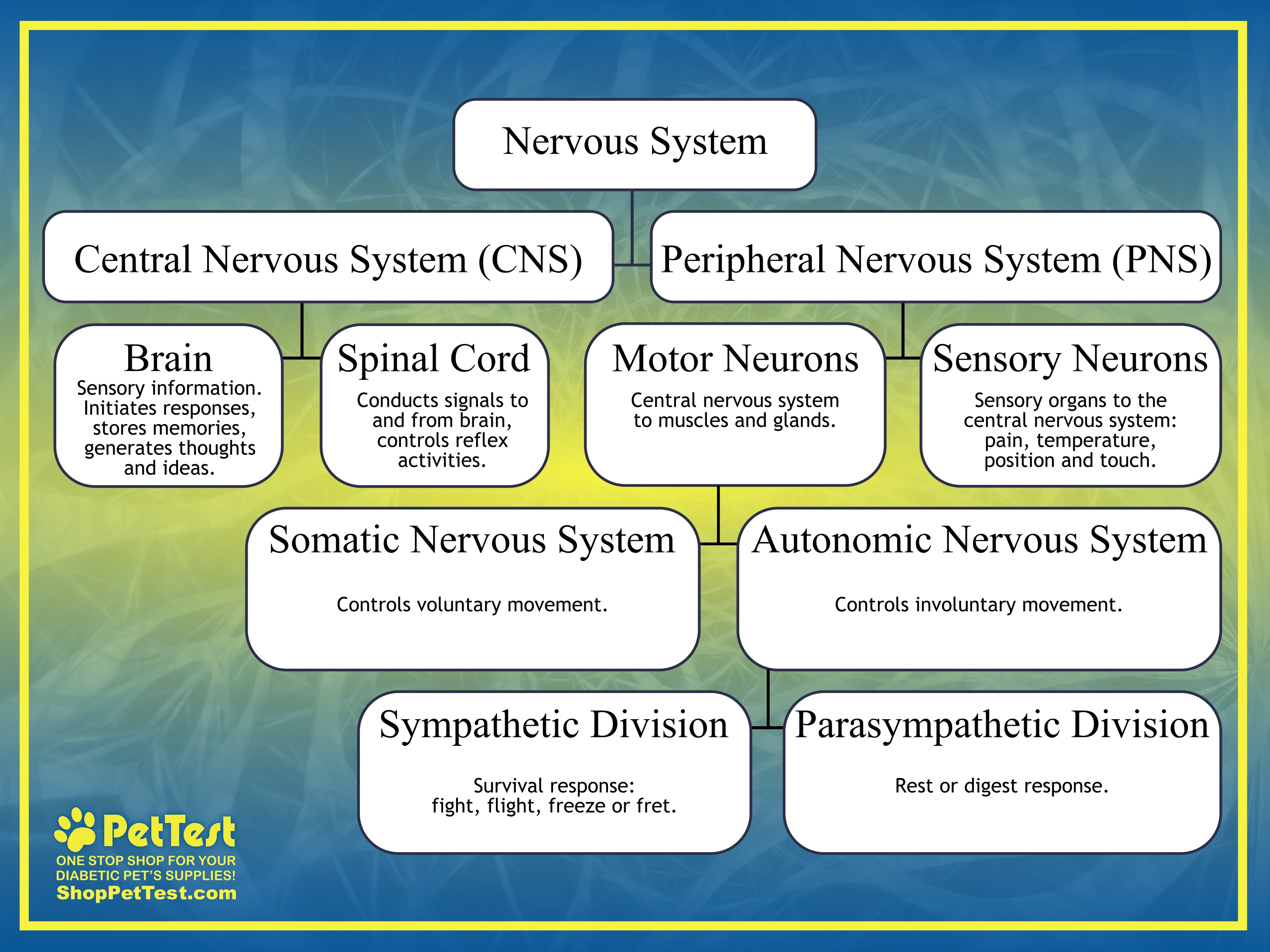The Canine Nervous System and Stress
I haven't written a blog regarding canine anatomy in some time so today I want to go over the canine nervous system, each function and the effects of stress. It is important to understand what happens when a diabetic dog is under stress because blood glucose levels can increase or drop.
Grab a cup of your favorite caffeinated beverage and let’s jump right in!
The canine nervous system is made up of the central nervous system (CNS) and the peripheral nervous system (PNS). Both are broken down into different categories and subcategories. These subcategories are responsible for different reactions to environmental stimuli and subconscious actions that the body makes.
The nervous system and its functions:

- Central nervous system (CNS)
- Brain – sensory information. Initiates responses, stores memories, generates thought and ideas.
- Spinal cord – conducts signals to and from the brain, controls reflex activities.
- Peripheral nervous system (PNS)
- Motor neurons – central nervous
system to muscles and glands.
- Somatic nervous system (SNS) – controls voluntary movement.
- Autonomic nervous system (ANS) –
controls involuntary responses.
- Sympathetic division – Fight or flight, survival response.
- Parasympathetic division – Rest or digest response.
- Sensory neurons – sensory organs to the central nervous system: pain, temperature, position and touch.
- Motor neurons – central nervous
system to muscles and glands.
The sympathetic division of the autonomic nervous system is the area that controls the survival response of a dog when they feel danger; think of the term “the 4 F’s” or “fight, flight, freeze or fret.” When a dog is in survival response some examples of responses are:
- Fight – showing aggression: lunge, attack, bite, snarl, growl, hackles raised.
- Flight – near panic mode, tries to escape or hide.
- Freeze – holding completely still, not reactionary at all.
- Fret – pacing, panting, nervous, overactive, cannot calm down.
When the sympathetic division is activated, hormones are released in what is called sympathetic outflow. These hormones include adrenaline, noradrenaline and cortisol.
When these hormones are released during a survival response in a dog these are some of the things that happen:
- The liver dumps glucose into the bloodstream for extra energy to be used by the body.
- Heart rate is increased.
- Force of heart contraction is increased.
- Blood pressure is increased.
- Lung capacity is increased by dilating bronchioles.
- Blood flow is decreased by constriction of blood vessels to the kidneys to slow production of urine.
- Digestion process slowed down.
- Pupils dilated. Increased muscle tension.
- Increased blood clotting.
Once a dog is out of the survival response the parasympathetic division of the autonomic nervous system secretes acetylcholine to restore the body to a restful state, or “rest and digest.”
When a dog is in survival response continually, the stress hormones can be debilitating and can cause long term illnesses and diseases since the immune system is suppressed while in survival response.
Some of the following illnesses can be the result of a dog in continual survival response:
- Lack of appetite, weight loss
- Chronic diarrhea
- Digestive ulcers
- High blood pressure
- Sleep deprivation / insomnia
- Insulin resistance
- Depression
- Slow wound healing
Dogs that are in chronic survival response can have shortened lifespans as well. Once a dog is out of survival response it can take 72 hours for effects to fade.
Now that we have gotten through the anatomy of the nervous system, I want to concentrate on the survival response and what that means for a diabetic dog.
When a diabetic dog is in survival response cortisol and epinephrine (adrenaline) are increased and these hormones can cause insulin resistance, or high blood glucose.
Conversely, while a dog is in survival response the liver dumps glucose into the bloodstream and this can cause a hypoglycemic event.
These actions by the body are precisely why it is recommended to run blood glucose curves at home. If your dog is at the vet’s office for the day they are under stress, even if they love the vet and staff. This can make curves done at the vet’s office inaccurate. We have often seen in our Facebook group that a vet curve is either much higher or lower than home testing results.
When taking Lucy to the vet’s her blood glucose levels were increased by 100 points or more. She loved the vet, staff and car rides but it did affect her blood glucose. Once she had lost most of her sight these visits were much more stressful and made a bigger impact on her blood glucose levels.
I hope that today’s blog has educated you a bit about the canine nervous system and the affects of stress. If you need help learning how to test blood glucose levels, please read the following blogs:
The Benefits of At Home Pet Health Tests: https://shoppettest.com/blog/the-benefits-of-athome-pet-health-tests/
Have No Fear Your Lancing Tutorial is Here!: https://shoppettest.com/blog/have-no-fear-your-lancing-tutorial-is-here-/
A Quick Guide to Reading Pet Glucose Monitors: https://shoppettest.com/blog/a-quick-guide-to-reading-pet-glucose-meters/
If you have any questions, comments or suggestions, please start a conversation below.
Until next week stay comfy, cool and caffeinated!
Michelle Miller-Matlock
AAHA Certified Diabetes Educator
Administrator of Diabetic Dog Owners on Facebook
Founder/Administrator of DDO: Diabetic Dog Owners University
Want to learn all you can in a simple and easy to follow format? Please join DDO-U: Diabetic Dog Owners University, sponsored by PetTest.
Be sure to join the PetTest family on Facebook and Instagram. PetTest has fun, interactive posts AND they have fabulous giveaways every week!
Do you need a blood glucose meter kit for your diabetes arsenal? Click here to purchase one today!
For a printable version of this blog click here.

